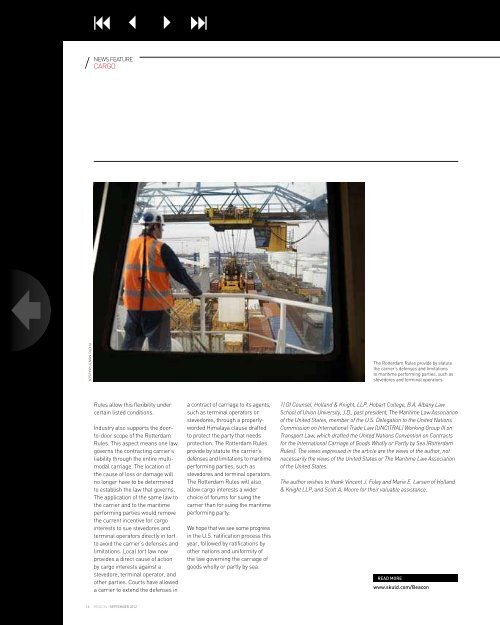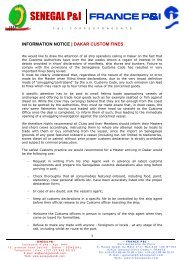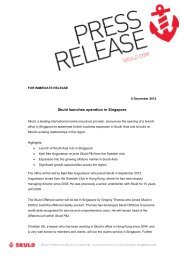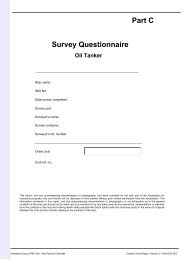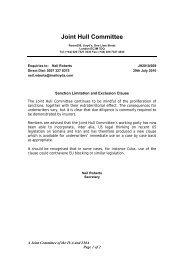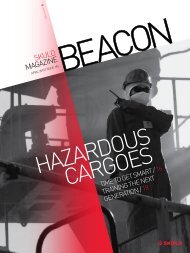Flip book - Skuld
Flip book - Skuld
Flip book - Skuld
- No tags were found...
You also want an ePaper? Increase the reach of your titles
YUMPU automatically turns print PDFs into web optimized ePapers that Google loves.
NEWS featureNEWS feature/ CargoCargo /By Binoy Kumar DubeyClaims Executive, <strong>Skuld</strong>binoy.dubey@skuld.comProject cargoCan you handle it?<strong>Skuld</strong> has experienced a series of cargo claims caused by bad stowageand improper securing of project cargoes. A recent case involving aconsignment of heat exchangers shipped from the Far East to theMiddle East is a good example.The transport units were stacked vertically three high, with each stackholding six heat exchangers. To form each unit, two heat exchangers,each weighing about 11 MT, were secured to one another with threeseparate H-girder support structures, one fitted near each end andone in the mid-section. Each support structure comprised two verticaland two transverse girders, bolted together to form a ‘box’ around theunit’s circumference. The support structures were not secured to the heatexchangers, and the heat exchangers were not secured to each other.Photo: Monty RakusenRules allow this flexibility undercertain listed conditions.Industry also supports the doorto-doorscope of the RotterdamRules. This aspect means one lawgoverns the contracting carrier’sliability through the entire multimodalcarriage. The location ofthe cause of loss or damage willno longer have to be determinedto establish the law that governs.The application of the same law tothe carrier and to the maritimeperforming parties would removethe current incentive for cargointerests to sue stevedores andterminal operators directly in tortto avoid the carrier’s defenses andlimitations. Local tort law nowprovides a direct cause of actionby cargo interests against astevedore, terminal operator, andother parties. Courts have alloweda carrier to extend the defenses ina contract of carriage to its agents,such as terminal operators orstevedores, through a properlywordedHimalaya clause draftedto protect the party that needsprotection. The Rotterdam Rulesprovide by statute the carrier’sdefenses and limitations to maritimeperforming parties, such asstevedores and terminal operators.The Rotterdam Rules will alsoallow cargo interests a widerchoice of forums for suing thecarrier than for suing the maritimeperforming party.We hope that we see some progressin the U.S. ratification process thisyear, followed by ratifications byother nations and uniformity ofthe law governing the carriage ofgoods wholly or partly by sea.The Rotterdam Rules provide by statutethe carrier’s defenses and limitationsto maritime performing parties, such asstevedores and terminal operators.1) Of Counsel, Holland & Knight, LLP, Hobart College, B.A, Albany LawSchool of Union University, J.D., past president, The Maritime Law Associationof the United States, member of the U.S. Delegation to the United NationsCommission on International Trade Law (UNCITRAL) Working Group III onTransport Law, which drafted the United Nations Convention on Contractsfor the International Carriage of Goods Wholly or Partly by Sea (RotterdamRules). The views expressed in the article are the views of the author, notnecessarily the views of the United States or The Maritime Law Associationof the United States.The author wishes to thank Vincent J. Foley and Marie E. Larsen of Holland& Knight LLP, and Scott A. Moore for their valuable assistance.read morewww.skuld.com/BeaconAlthough the heat exchangers were stencilled with ‘DO NOT USEFORKLIFT’ on their outer shells, clearly indicating their fragile nature,charterers declared cargo as ‘fully stackable’.Inevitable damageAt the discharge port, some heat exchangers, especially those stowedat the bottom of the hold, were found damaged and a USD 1.3 millionclaim made.Under the vessel’s motion, support-structure crossbars (those that sitacross the units) dug into the frames of the heat exchangers below.The crossbars twisted and the top surface of the side frames of thebottom and middle tiers subsequently crumpled downwards due to thesuper-incumbent weight. Additionally, the bottom sections of the lowerside frames of all three tiers crumpled in the crossbar region.To summarise, damage was caused by a combination of insufficientpackaging, poor stowage, inadequate support/dunnaging anddeficient lashing.Listen to the expertsThere is great diversity in methods of loading, stowage and securingproject cargoes. Although the final say remains with the ship’s master,he and his crew may not be technically skilled or experienced enoughto judge the adequacy and suitability of stowage and cargo-securingmethods. Consequently, it is essential to use the expertise of acompetent local expert or surveyor for supervising loading, stowageand securing of project cargoes.As these cargoes normally have higher value and correspondinglyhigher claims, members should consult <strong>Skuld</strong> or its correspondentsfor general loss prevention advice and guidance on appointing a loadingsurveyor or expert.Damage was caused by a combination of insufficient packaging, poor stowage, inadequatesupport/dunnaging and deficient lashing.“heatexchangers,especiallythosestowed atthe bottomof the hold,were founddamagedand a USD1.3 millionclaim made”/What is project cargo?/ Project cargo is a term usedto broadly describe thetransportation of large,heavy, high-value or projectcriticalequipment. It is alsocommonly referred to as‘heavy lift’.Source: Wikipedia.16 beacon / September 2012beacon / september 2012 17


